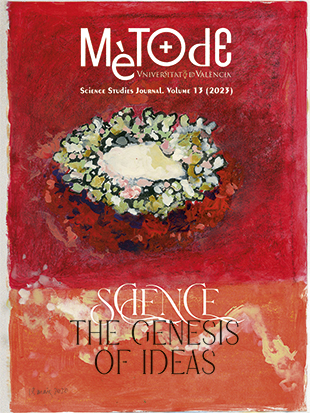Zoonotic diseases: Can the transmission of pathogens between animals and humans be controlled?
DOI:
https://doi.org/10.7203/metode.13.24001Keywords:
pandemic, global health, One Health, animal health surveillance, zoonoses Abstract
Abstract
After being associated with more than six million deaths so far, the Covid-19 pandemic is one of the worst diseases of animal origin known to date. Other zoonotic diseases such as severe acute respiratory syndrome (2002–2004, which mainly affected China), Middle East respiratory syndrome (2012, mainly affecting the Middle East), Ebola (2013–2016 in West Africa), and Rift Valley fever (from 2016 to the present) have also caused major disease outbreaks in recent decades. In addition, and especially in low-income countries, some zoonotic diseases such as tuberculosis and rabies are endemic and cause thousands of deaths. Of note, up to 60 % of known infectious diseases and 75 % of emerging infectious diseases have an animal origin and are responsible for public health problems and economic losses.
 Downloads
Downloads
 References
References
Baker, R. E., Mahmud, A. S., Miller, I. F., Rajeev, M., Rasambainarivo, F., Rice, B. L., Takahashi, S., Tatem, A. J., Wagner, C. E., Wang, L., Wesolowski, A., & Metcalf, J. E. (2022). Infectious disease in an era of global change. Nature Reviews Microbiology, 20, 193–205. https://doi.org/10.1038/s41579-021-00639-z
Church, D. L. (2004). Major factors affecting the emergence and re-emergence of infectious diseases. Clinics in Laboratory Medicine, 24(3), 559–586. https://doi.org/10.1016/j.cll.2004.05.008
Jones, K. E., Patel, N. G., Levy, M. A., Storeygard, A., Balk, D., Gittleman, J. L., & Daszak, P. (2008). Global trends in emerging infectious diseases. Nature, 451, 990–993. https://doi.org/10.1038/nature06536
Mastutik, G., Rohman, A., I’tishom, R., Ruiz-Arrondo, I., & Blas, I. (2022). Experimental and natural infections of severe acute respiratory syndrome-related coronavirus 2 in pets and wild and farm animals. Veterinary World, 15(3), 565–589. https://doi.org/10.14202/vetworld.2022.565-589
Pearce-Duvet, J. M. C. (2006). The origin of human pathogens: Evaluating the role of agriculture and domestic animals in the evolution of human disease. Biological Reviews, 81, 369–382. https://doi.org/10.1017/S1464793106007020
Taylor, L. H., Latham, S. M., & Woolhouse, M. E. (2001). Risk factors for human disease emergence. Philosophical Transactions B, 356, 983–989. https://doi.org/10.1098/rstb.2001.0888
Temmam, S., Vongphayloth, K., Baquero, E., Munier, S., Bonomi, M., Regnault, B., Douangboubpha, B., Karami, Y., Chrétien, D., Sanamxay, D., Xayaphet, V., Paphaphanh, P., Lacoste, V., Somlor, S., Lakeomany, K., Phommavanh, N., Pérot, P., Dehan, O., Amara, F., ... Eloit, M. (2022). Bat coronaviruses related to SARS-CoV-2 and infectious for human cells. Nature, 604(7905), 330–336. https://doi.org/10.1038/s41586-022-04532-4
Walker, D. H., Barbour, A. G., Oliver, J. H., Lane, R. S., Dumler, J. S., Dennis, D. T., Persing, D. H., Azad, A. F., & McSweegan, E. (1996). Emerging bacterial zoonotic and vector-borne diseases. Ecological and epidemiological factors. JAMA, 275(6), 463–469. https://doi.org/10.1001/jama.1996.03530300047039
Walsh, T. J., & Groll, A. H. (1999). Emerging fungal pathogens: Evolving challenges to immunocompromised patients for the twenty-first century. Transplant Infectious Disease, 1(4), 247–261. https://doi.org/10.1034/j.1399-3062.1999.010404.x
World Bank Group. (2018). One Health. Operational framework for strengthening human, animal and environmental public health systems at their interface. http://documents.worldbank.org/curated/en/961101524657708673/pdf/122980-REVISED-PUBLIC-World-Bank-One-Health-Framework-2018.pdf
Zhou, H., Ji, J., Chen, X., Bi, Y., Li, J., Wang, Q., Hu, T., Song, H., Zhao, R., Chen, Y., Cui, M., Zhang, Y., Hughes, A. C., Holmes, E. C., & Shi, W. (2021). Identification of novel bat coronaviruses sheds light on the evolutionary origins of SARS-CoV-2 and related viruses. Cell, 184(17), 4380–4391.e14. https://doi.org/10.1016/j.cell.2021.06.008
Published
How to Cite
-
Abstract1503
-
HTML1592
-
PDF614
Issue
Section
License
![]()
All the documents in the OJS platform are open access and property of their respective authors.
Authors publishing in the journal agree to the following terms:
- Authors keep the rights and guarantee Metode Science Studies Journal the right to be the first publication of the document, licensed under a Creative Commons Attribution-NonCommercial-NoDerivatives 4.0 International License that allows others to share the work with an acknowledgement of authorship and publication in the journal.
- Authors are allowed and encouraged to spread their work through electronic means using personal or institutional websites (institutional open archives, personal websites or professional and academic networks profiles) once the text has been published.





